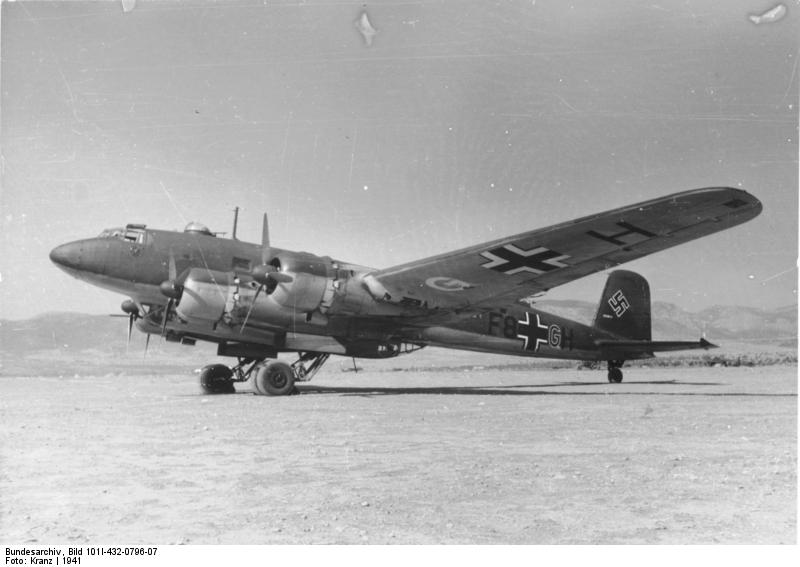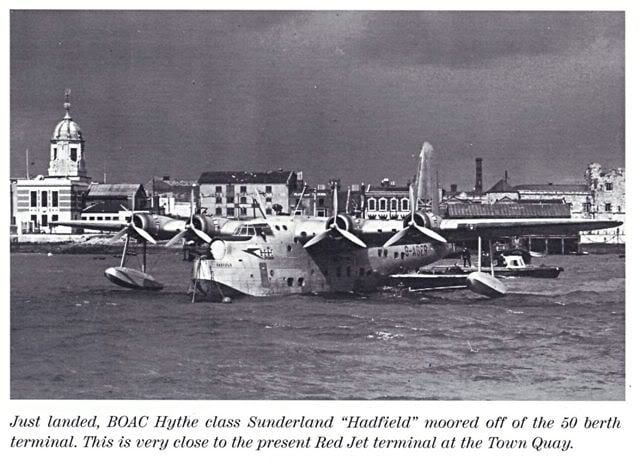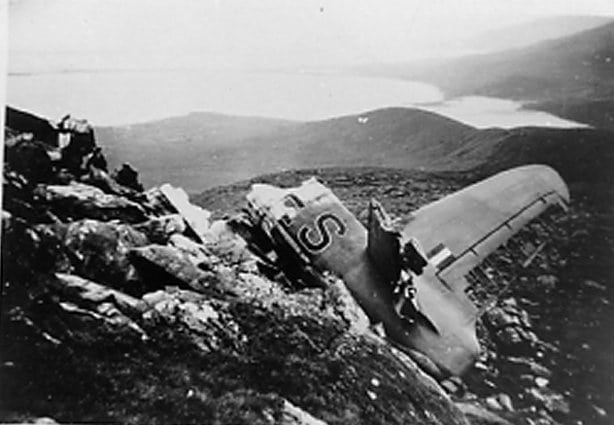World War II Plane Crash Site in Kerry
http://www.invisible-ireland.com/world-war-ii-plane-crash-site-in-kerry

 The Dingle Peninsula, a popular holiday destination for tourists. Famous for walking, surfing and Fungi the Dolphin (how long to Dolphins actually live?) it is little known that it was the site of numerous allied and German plane crashes during the Second World War. Sitting on the north coast of the peninsula is the imposing Mount Brandon (named after Saint Brendan) reaching 952 meters.Yes the same Saint Brendan of ‘The Voyage of Saint Brendan’ Fame in which he finds Jasconius and encounters Paul the hermit. There is an annual pilgrimage up the slopes with a large metal cross on its peak. The pilgrimage stops at the ruins of a stone building call Sáipéilín Bréanainn (Brendan’s Oratory), believed to have been frequented by the intrepid traveller himself. On the 20th August 1940 a Luftwaffe Focke Wulf 200 ‘Condor’ aircraft took off from Nazi occupied France with a crew of 6. Its flight path took it from Bordeaux to the West Coast of Ireland for weather reconnaissance.
The Dingle Peninsula, a popular holiday destination for tourists. Famous for walking, surfing and Fungi the Dolphin (how long to Dolphins actually live?) it is little known that it was the site of numerous allied and German plane crashes during the Second World War. Sitting on the north coast of the peninsula is the imposing Mount Brandon (named after Saint Brendan) reaching 952 meters.Yes the same Saint Brendan of ‘The Voyage of Saint Brendan’ Fame in which he finds Jasconius and encounters Paul the hermit. There is an annual pilgrimage up the slopes with a large metal cross on its peak. The pilgrimage stops at the ruins of a stone building call Sáipéilín Bréanainn (Brendan’s Oratory), believed to have been frequented by the intrepid traveller himself. On the 20th August 1940 a Luftwaffe Focke Wulf 200 ‘Condor’ aircraft took off from Nazi occupied France with a crew of 6. Its flight path took it from Bordeaux to the West Coast of Ireland for weather reconnaissance.

Developing engine problems in the early morning the four engine plane lost altitude as it attempted return along the Irish coast to Western France. As is common in coastal areas there was dense fog waiting for the rising sun to burn it off. The German captain headed for Tralee bay to ditch the dying aircraft but with primitive navigation tools the aircraft had lost too must altitude to scrap over Mount Brandon. With a gap in the fog Captain Kurt Mollenhauer managed react to the rising mountain and the plane belly landed on Faha Ridge with aNumber of The injured crew.The German crew were relieved to have landed in Ireland. Ireland remained neutral throughout the war at the behest of Éamon de Valera, the Taoiseach (Prime minister) and his Government despite pressure from the Allies and particularly the British. At the outbreak of war Ireland was a member of the British Commonwealth but had declared independence from British rule in 1921 and enacted a constitution in 1937 (Ireland only became a republic in 1948). Therefore when the war broke out Ireland was only fledging state that had was just beginning to stand on its own two feet and heal the divides of a recent Civil War (28 June 1922 – 24 May 1923) that followed the War for Independence (21 January 1919 – 11 July 1921).  However it should be noted that it is believed that over 60,000 Irish volunteered to fight with the British army during the war. This figure is difficult to confirm however do to identities being hidden do to the obvious tensions of the period. .The local Garda (police) met the Germans as they carried their wounded off Mount Brandon on the pilgrims trail. They were duly given a glass of milk by a local by all accounts before they were then taken by the Irish army, the 5th Infantry Battalion, to Collins Barracks in Cork. At the time Ireland had nowhere to hold prisoners of war. In fact they were the first Germans to be held here.
However it should be noted that it is believed that over 60,000 Irish volunteered to fight with the British army during the war. This figure is difficult to confirm however do to identities being hidden do to the obvious tensions of the period. .The local Garda (police) met the Germans as they carried their wounded off Mount Brandon on the pilgrims trail. They were duly given a glass of milk by a local by all accounts before they were then taken by the Irish army, the 5th Infantry Battalion, to Collins Barracks in Cork. At the time Ireland had nowhere to hold prisoners of war. In fact they were the first Germans to be held here.  A prisoner internment was built at the Curragh Army base in Kildare where the Germans where eventually moved. The last crew member Kurt Kyck, who had married and lived in Ireland, died in August 2010.Remains of the plane are still believed to be visible on the slopes of Mount Brandon. The World War II Plane Crash Site in Kerry photos above were actually taken in 1998. However If you visit O’Connor’s pub in Cloghane you will find an engine from the actual aircraft sitting outside the front door. Yes it been sitting there watching the world go by since 1940. You will also find a plaque on the wall commemorating the crash of a British Overseas Airways Corporation (predecessor of British Airways) on the foggy slopes of Mount Brandon on 27th of July, 1943 killing 15 of the 25 passengers and crew.An engine from the Luftwaffe Focke Wulf and the BOAC plaque in Cloghane
A prisoner internment was built at the Curragh Army base in Kildare where the Germans where eventually moved. The last crew member Kurt Kyck, who had married and lived in Ireland, died in August 2010.Remains of the plane are still believed to be visible on the slopes of Mount Brandon. The World War II Plane Crash Site in Kerry photos above were actually taken in 1998. However If you visit O’Connor’s pub in Cloghane you will find an engine from the actual aircraft sitting outside the front door. Yes it been sitting there watching the world go by since 1940. You will also find a plaque on the wall commemorating the crash of a British Overseas Airways Corporation (predecessor of British Airways) on the foggy slopes of Mount Brandon on 27th of July, 1943 killing 15 of the 25 passengers and crew.An engine from the Luftwaffe Focke Wulf and the BOAC plaque in Cloghane
The list of crashes include:
 20th August 1940 a German Luftwaffe plane known as a Focke Wulf 200 ”Condor” crash landed on Faha Ridge above Cloghane. The crew of six survived and were the first aircrew from Germany to land in Ireland during the war years and were happily imprisoned for the entire war. Imprisoned in the Curragh Internment Camp is a loose term as it is a well-known fact that the internees were allowed sign out to attend horse racing at the Curragh, to attend public dances and to visit the German Embassy. While visiting the German Embassy two German internees met their future Irish wives.
20th August 1940 a German Luftwaffe plane known as a Focke Wulf 200 ”Condor” crash landed on Faha Ridge above Cloghane. The crew of six survived and were the first aircrew from Germany to land in Ireland during the war years and were happily imprisoned for the entire war. Imprisoned in the Curragh Internment Camp is a loose term as it is a well-known fact that the internees were allowed sign out to attend horse racing at the Curragh, to attend public dances and to visit the German Embassy. While visiting the German Embassy two German internees met their future Irish wives.
28 July 1943: A BOAC Civilian Short Sunderland III Flying Boat crashed due to a navigation error onto the lower slopes of Mount Brandon while flying from West Africa to Foynes Flying Boat Base. Ten of the twenty-five on board were killed in the wreck. An anchor from the wreck is in O’Connor’s Bar and Guest House.
 22 August 1943: A RAF Short Sunderland III Flying Boat belonging to 201 Squadron crashed while flying a patrol in the Atlantic, out of Castle Archdale. It crashed into the lower slopes of Mount Brandon. Eight of the crew of eleven were killed. A plaque commemorating those killed is in O’Connor’s Bar and Guest House.
22 August 1943: A RAF Short Sunderland III Flying Boat belonging to 201 Squadron crashed while flying a patrol in the Atlantic, out of Castle Archdale. It crashed into the lower slopes of Mount Brandon. Eight of the crew of eleven were killed. A plaque commemorating those killed is in O’Connor’s Bar and Guest House.
 20th December 1943 an RAF Vickers Wellington XVI with a Polish crew of 6 crashes with all 6 killed.
20th December 1943 an RAF Vickers Wellington XVI with a Polish crew of 6 crashes with all 6 killed.


